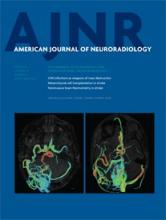Research ArticleBrain
Progression of Microstructural Damage in Spinocerebellar Ataxia Type 2: A Longitudinal DTI Study
M. Mascalchi, N. Toschi, M. Giannelli, A. Ginestroni, R. Della Nave, E. Nicolai, A. Bianchi, C. Tessa, E. Salvatore, M. Aiello, A. Soricelli and S. Diciotti
American Journal of Neuroradiology June 2015, 36 (6) 1096-1101; DOI: https://doi.org/10.3174/ajnr.A4343
M. Mascalchi
aFrom the Quantitative and Functional Neuroradiology Research Unit (M.M.), Meyer Children and Careggi Hospitals of Florence, Florence, Italy
b“Mario Serio” Department of Experimental and Clinical Biomedical Sciences (M.M., A.B.), University of Florence, Florence, Italy
N. Toschi
cMedical Physics Section (N.T.), Department of Biomedicine and Prevention, University of Rome “Tor Vergata,” Rome, Italy
dDepartment of Radiology (N.T.), Athinoula A. Martinos Center for Biomedical Imaging, Boston, Massachusetts
eHarvard Medical School (N.T.), Boston, Massachusetts
M. Giannelli
fUnit of Medical Physics (M.G.), Pisa University Hospital “Azienda Ospedaliero-Universitaria Pisana,” Pisa, Italy
A. Ginestroni
gNeuroradiology Unit (A.G.), Careggi General Hospital, Florence, Italy
R. Della Nave
h“San Giuseppe” Hospital (R.D.N.), Empoli, Italy
E. Nicolai
iIRCSS SDN Foundation (E.N., M.A., A.S.), Naples, Italy
A. Bianchi
aFrom the Quantitative and Functional Neuroradiology Research Unit (M.M.), Meyer Children and Careggi Hospitals of Florence, Florence, Italy
C. Tessa
jUnit of Radiology (C.T.), Versilia Hospital, Lido di Camaiore, Italy
E. Salvatore
kDepartment of Neurological Sciences (E.S.), University of Naples Federico II, Naples, Italy
M. Aiello
iIRCSS SDN Foundation (E.N., M.A., A.S.), Naples, Italy
A. Soricelli
iIRCSS SDN Foundation (E.N., M.A., A.S.), Naples, Italy
lUniversity of Naples Parthenope (A.S.), Naples, Italy
S. Diciotti
mDepartment of Electrical, Electronic, and Information Engineering “Guglielmo Marconi” (S.D.), University of Bologna, Cesena, Italy.

References
- 1.↵
- 2.↵
- Orr HT
- 3.↵
- Seidel K,
- Siswanto S,
- Brunt ER, et al
- 4.↵
- 5.↵
- Mascalchi M,
- Vella A
- 6.↵
- 7.↵
- 8.↵
- Agosta F,
- Pievani M,
- Sala S, et al
- 9.↵
- 10.↵
- Zhang Y,
- Tartaglia MC,
- Schuff N, et al
- 11.↵
- 12.↵
- Tessa C,
- Giannelli M,
- Della Nave R, et al
- 13.↵
- Della Nave R,
- Ginestroni A,
- Tessa C, et al
- 14.↵
- Cosottini M,
- Giannelli M,
- Siciliano G, et al
- 15.↵
- 16.↵
- Mandelli ML,
- De Simone T,
- Minati L, et al
- 17.↵
- 18.↵
- 19.↵
- Della Nave R,
- Ginestroni A,
- Tessa C, et al
- 20.↵
- Della Nave R,
- Ginestroni A,
- Diciotti S, et al
- 21.↵
- 22.↵
- 23.↵
- 24.↵
- 25.↵
- 26.↵
- Teipel SJ,
- Meindl T,
- Wagner M, et al
- 27.↵
- Vandenberghe W,
- Demaerel P,
- Dom R, et al
- 28.↵
- Weaver KE,
- Richards TL,
- Liang O, et al
- 29.↵
- Sritharan A,
- Egan GF,
- Johnston L, et al
- 30.↵
- Seppi K,
- Schocke MF,
- Mair KJ, et al
- 31.↵
- Smith SM,
- Johansen-Berg H,
- Jenkinson M, et al
- 32.↵
- Smith SM,
- Jenkinson M,
- Johansen-Berg H, et al
- 33.↵
- Pareyson D,
- Gellera C,
- Castellotti B, et al
- 34.↵
- Filla A,
- DeMichele G,
- Caruso G, et al
- 35.↵
- Smith SM,
- Jenkinson M,
- Woolrich MW, et al
- 36.↵
- Leemans A,
- Jones DK
- 37.↵
- Cook PA,
- Bai Y,
- Nedjati-Gilani S, et al
- 38.↵
- 39.↵
- Zhang H,
- Avants BB,
- Yushkevich PA, et al
- 40.↵
- Ennis DB,
- Kindlmann G
- 41.↵
- Douaud G,
- Jbabdi S,
- Behrens TE, et al
- 42.↵
- 43.↵
- Smith SM,
- Nichols TE
- 44.↵
- 45.↵
- Brenneis C,
- Bosch SM,
- Schocke M, et al
- 46.↵
- Goel G,
- Pal PK,
- Ravishankar S, et al
- 47.↵
- 48.↵
- 49.↵
- Kipps CM,
- Duggins AJ,
- Mahant N, et al
- 50.↵
- Thieben MJ,
- Duggins AJ,
- Good CD, et al
- 51.↵
- Ginestroni A,
- Battaglini M,
- Della Nave R, et al
- 52.↵
- 53.↵
- Huang H,
- Fan X,
- Weiner M, et al
- 54.↵
- Acosta-Cabronero J,
- Williams GB,
- Pengas G, et al
- 55.↵
- Rosas HD,
- Lee SY,
- Bender AC, et al
- 56.↵
- Salat DH,
- Tuch DS,
- van der Kouwe AJ, et al
- 57.↵
- Kelp A,
- Koeppen AH,
- Petrasch-Parwez E, et al
- 58.↵
- Reetz K,
- Costa AS,
- Mirzazade S, et al
- 59.↵
- 60.↵
In this issue
American Journal of Neuroradiology
Vol. 36, Issue 6
1 Jun 2015
Advertisement
M. Mascalchi, N. Toschi, M. Giannelli, A. Ginestroni, R. Della Nave, E. Nicolai, A. Bianchi, C. Tessa, E. Salvatore, M. Aiello, A. Soricelli, S. Diciotti
Progression of Microstructural Damage in Spinocerebellar Ataxia Type 2: A Longitudinal DTI Study
American Journal of Neuroradiology Jun 2015, 36 (6) 1096-1101; DOI: 10.3174/ajnr.A4343
0 Responses
Progression of Microstructural Damage in Spinocerebellar Ataxia Type 2: A Longitudinal DTI Study
M. Mascalchi, N. Toschi, M. Giannelli, A. Ginestroni, R. Della Nave, E. Nicolai, A. Bianchi, C. Tessa, E. Salvatore, M. Aiello, A. Soricelli, S. Diciotti
American Journal of Neuroradiology Jun 2015, 36 (6) 1096-1101; DOI: 10.3174/ajnr.A4343
Jump to section
Related Articles
Cited By...
- The Pattern and Staging of Brain Atrophy in Spinocerebellar Ataxia Type 2 (SCA2): MRI Volumetrics from ENIGMA-Ataxia
- Association of the Level of Neurofilament Light With Disease Severity in Patients With Spinocerebellar Ataxia Type 2
- Common genetic variation influencing human white matter microstructure
This article has not yet been cited by articles in journals that are participating in Crossref Cited-by Linking.
More in this TOC Section
Similar Articles
Advertisement











